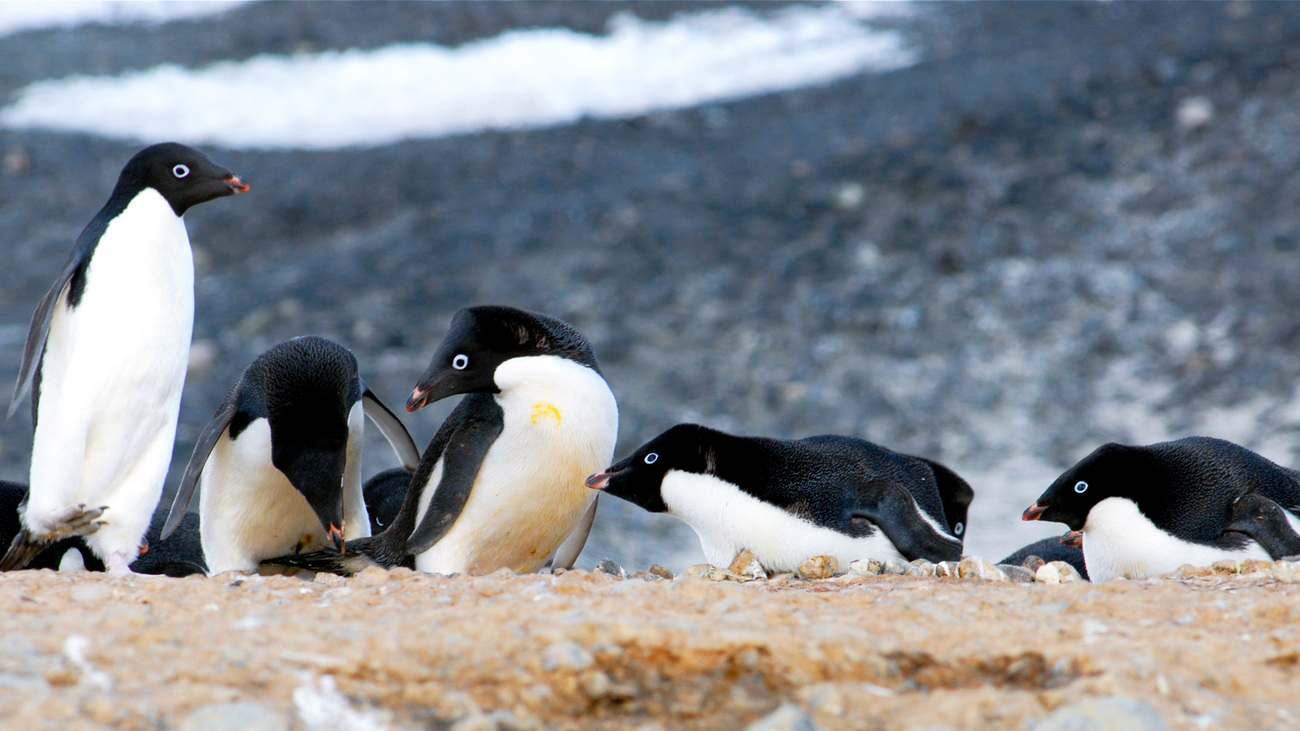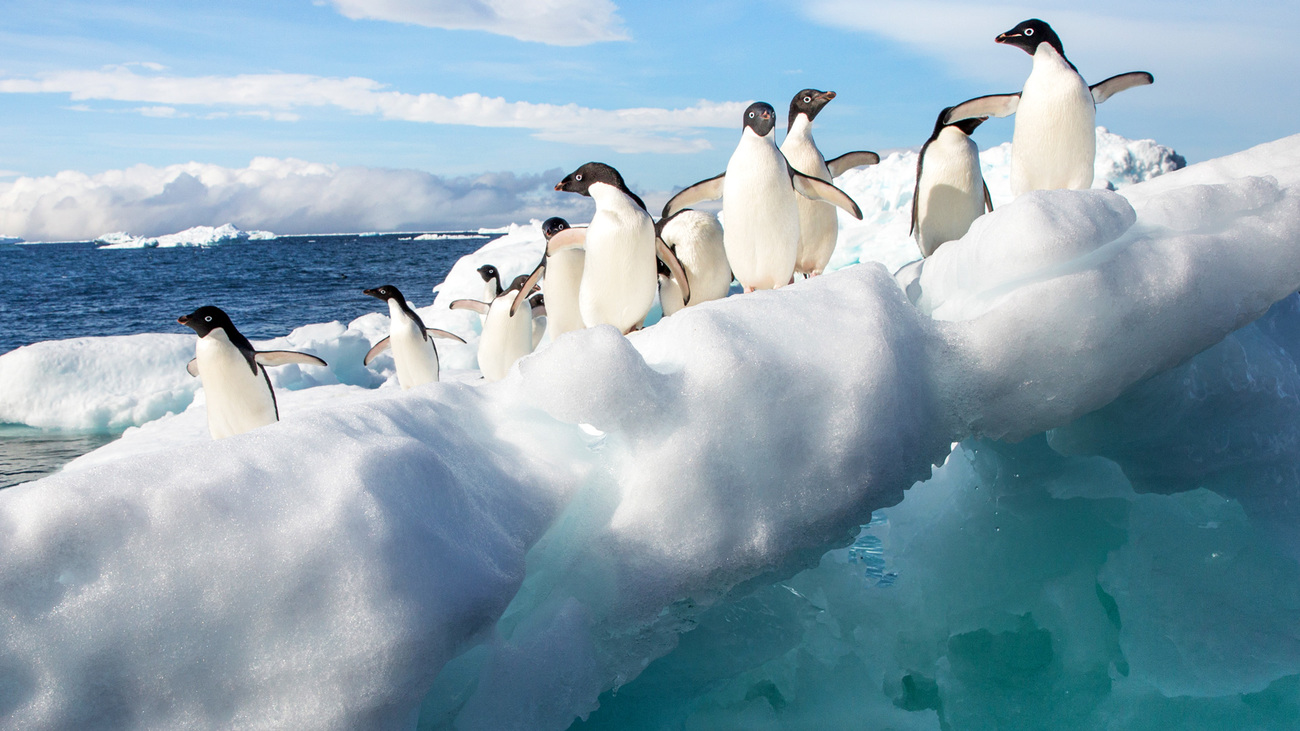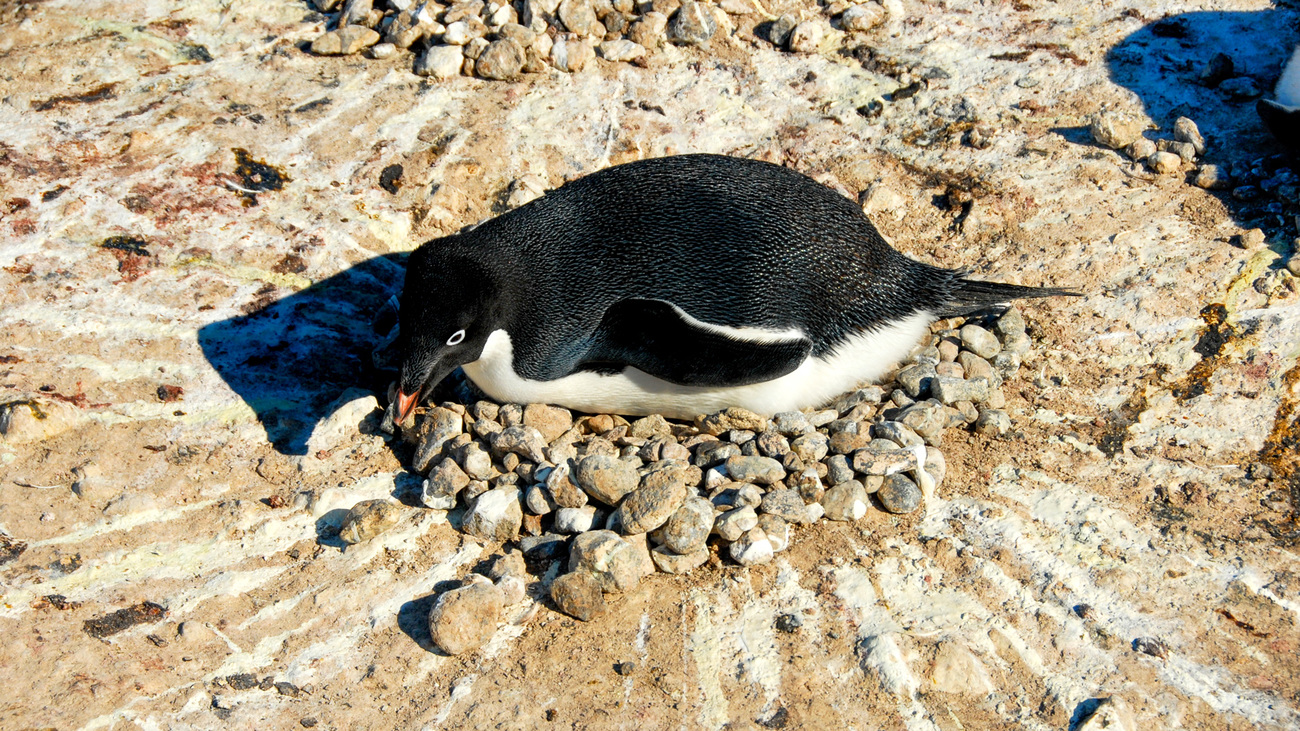Adélie penguins
What is an Adélie penguin?
Adélie penguins are the most widespread penguin species. They live across the entire coast of Antarctica and their population currently stands at over 10 million. The best way to tell an Adélie penguin apart from other species is by looking at their eyes, as they have distinctive white rings around them. This trick won’t work, however, for a baby Adélie penguin, since they’re born with black eye rings instead of white.
Adélie penguins have dull orange beaks that don’t particularly stand out, and their feathers follow the typical black back and white belly pattern of other penguins. They can reach heights of around 73 centimetres (29 inches)—considerably smaller than emperor penguins, which can grow as tall as 130 centimetres (50 inches).
Adélie penguins are an important middle link in the Antarctic food chain. They feed on tiny krill and small fish and act as a food source for other animals like leopard seals and killer whales. As they live both on land and at sea, they also help to fertilise the soil by bringing nutrients from the ocean, like nitrogen, phosphorus, and carbon.
What is an Adélie penguin’s scientific name?
The scientific name for the Adélie penguin is Pygoscelis adeliae. The name Adélie comes from the island where the species was first discovered, which was named by French explorer Jules Dumont d’Urville after his wife, Adele.
Are Adélie penguins endangered?
Adélie penguins were considered near threatened from 2012 to 2016, and their status changed to least concern in 2020. The species was considered near threatened because projections suggested that their population would decline within three generations due to climate change. Recently, in good news for this penguin species, population increases have been recorded.
As these penguins rely on sea ice to survive, their success is closely linked to the amount of sea ice around Antarctica. It’s hard to predict how climate change will affect their habitat in the coming years, so it’s also difficult to say what will happen to Adélie penguins.
Where do Adélie penguins live?
Adélie penguins live in Antarctica for their entire lives, though they do move between different areas of the continent depending on the time of year. When it’s time to breed and lay eggs during the summer, they stay close to the coast, where they can find ground that isn’t covered in ice. In the winter, they head to the sea ice, where they can get the most out of their limited hunting time—the days become so short that there’s hardly any daylight for hunting.
Threats
Adélie penguins are threatened by the ongoing effects of climate change. They live in Antarctica, where the increase in the Earth’s temperature is felt the most.

Ice retraction
Adélie penguins are considered ice obligates, which means they need sea ice to survive. The primary reason for this is that their main source of food—krill—lives on the underside of ice sheets. As sea ice retracts, the number of krill decreases. Current studies project that the Earth could reach a temperature of 2°C above pre-industrial levels by 2042. If this happens, ice retraction would progress to a point where all penguin colonies north of a certain area could be lost, and other nearby colonies could be severely affected. It’s very important for us to keep monitoring these penguins and their reaction to ongoing change over the next two decades.
Severe snowfall
Increased snowfall has been observed in parts of Antarctica during the summer, which could affect the Adélie penguins. Shifts in weather can affect ecosystems in a variety of ways, including decreasing prey availability and attracting competing species.
Human intrusion
Human presence in Antarctica is increasing, and penguins living near human settlements, like Antarctic stations, are vulnerable to both air and water pollution. An oil spill in 1989, for example, killed an estimated 16% of local penguins.
Human infrastructure can also reduce the number of suitable breeding grounds, and some fisheries are built specifically to harvest Antarctic krill—overfishing could diminish penguins’ food supply.
FAQs
What do Adélie penguins look like?
The most striking part of an Adélie penguin is its eyes. Unlike emperor penguins, who have black eyes against black feathers, Adélie penguins have distinct bright white eye rings. It almost looks as if they have whites in their eyes like humans and are always widening their eyes in surprise.
The colouring of their feathers is somewhat similar to that of emperor penguins, with black on their backs, faces, and the upper sides of their wings, while their fronts and the undersides of their wings are white. Unlike emperor penguins, though, Adélie penguins don’t have yellow markings on their necks. They do have elongated feathers on the back of their heads that can spread out to form a crest.

How big are Adélie penguins?
Adult Adélie penguins don’t vary much in height—both males and females stand 70 to 73 centimetres (28 to 29 inches) tall. However, males do tend to be a bit larger than females and their weights range from four to six kilograms (nine to 13 pounds).
What do Adélie penguins eat?
Most of an Adélie penguin’s diet is made up of krill—tiny marine crustaceans that look a little like shrimp. However, they also eat various types of small fish, jellyfish, and squid. They prefer to hunt for food in shallow waters where there’s plenty of light, but, if they need to, they can dive as deep as 170 metres (560 feet). Adélie penguins are fast swimmers and can travel as far as 297 kilometres (185 miles) in one hunting trip.
Can Adélie penguins fly?
No. Adélie penguins are flightless birds, just like all other penguins. It’s thought that penguins did fly in the past, though no fossils of flying penguin ancestors have been found. The oldest penguin fossils we do have show that the birds have been flightless for at least 58 to 60 million years. Birds that can fly tend to have hollow bones to minimise their weight, but penguins now have more solid bones that have developed a structure better suited to diving and swimming than to flying.
Do Adélie penguins live in Antarctica?
Yes, Adélie penguins spend their entire lives living in Antarctica, either on the sea ice or in the water around it. Warmer months are spent on rocky coasts where the penguins nest, and winter is spent following the remaining daylight northwards so they can hunt. It’s much harder for penguins to see predators when diving in the dark, so they try to avoid hunting at night.

How do Adélie penguins survive in Antarctica?
Penguins have a number of highly specific adaptations that allow them to thrive in their Antarctic habitat. The first is their ability to cope with salt. Despite being surrounded by salt water, penguins can’t survive if they have too much salt in their bodies. To regulate their salt content, they have special glands above their eyes that excrete concentrated salt that the body doesn’t need.
Their fusiform-shaped bodies and adapted wings make them truly at home in the water, where they can dive deep and move with unparalleled speed and agility. This ability is crucial to their survival, as it gives them access to a wealth of food sources under the water—food sources that their flying counterparts could never reach.
Adélie penguins are also well-adapted to deal with the extreme cold, as they can control the blood flow to their feet and wings. Extremities are where animals, including humans, lose heat the fastest, so penguins divert blood flow from their feet towards their bodies to prevent heat loss. When they do this, their feet change colour from pink to white.
One more defence Adélie penguins have against the cold is their feathers. They’re extremely dense, built for heat retention at the base, and shaped for water repulsion at the tips. Penguins also spend a lot of time each day preening their feathers, which involves collecting waterproof oil from a gland near their tail with their beaks and spreading it over their feathers to prepare themselves for the water.
Do Adélie penguins migrate?
Yes. Summer months—in other words, the nesting season—are spent on rocky, ice-free coasts where it’s easier to incubate eggs. Winter months, on the other hand, are spent on pack-ice, and penguins migrate to wherever the pack-ice is suitable. According to the IUCN, migratory movement was far less common in the past when there was more winter sea ice available, and penguins would stay near the summer nesting sites all year round.
How do Adélie penguins mate?
When it’s time for breeding season, penguins make their way to the nesting grounds. Males make it there first and prepare for courting rituals by making a nest of stones. When the females arrive, the males put on a display of neck arching and beak thrusting to attract a mate. When they’re successful, they mate by standing on the female’s back.
How many eggs do Adélie penguins lay?
Adélie penguins lay two eggs after successful mating in late November or early December. The parents take turns incubating the eggs for around 35 days before they hatch.

Do Adélie penguins mate for life?
Adélie penguins do mate for life—as long as their partner remains punctual. If the male or female is late returning to the nesting grounds one year, the punctual half of the pair is forced to find a new partner if they want to breed that year. If they wait too long, then their chicks won’t hatch at the same time as everyone else’s, and this will affect their chances of survival. This also applies if a penguin’s mate dies or just stops turning up.
Why are Adélie penguins endangered?
Although Adélie penguins are not classified as endangered by the IUCN—they are considered least concern—they still face threats that will almost definitely affect their population in the future. These threats are caused almost entirely by climate change, which is leading to ice retraction, increasing sea levels, and severe snowfall.
How many Adélie penguins are left in the world?
The IUCN estimates that there are around 10,000,000 mature individuals, which doesn’t count infants and young penguins that haven’t reached sexual maturity. That means that there are more Adélie penguins in the world than there are cats.
How can you help?
IFAW is committed to protecting species threatened by climate change. We work to support nature-based solutions, including wildlife conservation, to combat the climate crisis.
